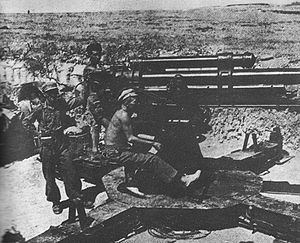| Battle of the Ebro | |||||||
|---|---|---|---|---|---|---|---|
| Part of the Spanish Civil War | |||||||
 Republican antiaircraft artillery in the Battle of the Ebro | |||||||
| |||||||
| Belligerents | |||||||
| Commanders and leaders | |||||||
| Strength | |||||||
|
80,000[1][2] Thomas: 70–80 field batteries[1] 27 anti-aircraft guns[1] Beevor: 22 tanks (T-26)[3] 150 guns[2] |
90,000 July: 100 fighters 140 bombers[4] 31 August: 100 tanks[4] 300 guns[4] 500 aircraft[4] | ||||||
| Casualties and losses | |||||||
|
Thomas: 10,000–15,000 killed[5] Jackson: 10,000[6] Preston: 7,150 killed[7] 20,000 wounded 19,563 captured 80 aircraft destroyed |
Thomas: 6,500 killed[5] Preston: 6,100 killed[7] Jackson: 5,000 killed[6] 30,000 wounded 5,000 captured | ||||||
The Battle of the Ebro (Spanish: Batalla del Ebro, Catalan: Batalla de l'Ebre) was the longest and largest battle of the Spanish Civil War and the greatest, in terms of manpower, logistics and material ever fought on Spanish soil. It took place between July and November 1938, with fighting mainly concentrated in two areas on the lower course of the Ebro River, the Terra Alta comarca of Catalonia, and the Auts area close to Fayón (Faió) in the lower Matarranya, Eastern Lower Aragon. These sparsely populated areas saw the largest array of armies in the war. The battle was disastrous for the Second Spanish Republic, with tens of thousands left dead or wounded and little effect on the advance of the Nationalists.
- ^ a b c Thomas, Hugh. The Spanish Civil War. Penguin Books. 2001. London. p.813
- ^ a b Beevor, Antony. The Battle for Spain. The Spanish Civil War 1936–1939. Penguin Books. London. 2006. p.350
- ^ Thomas, Hugh. The Spanish Civil War. Penguin Books. 2001. London. p.816
- ^ a b c d Beevor, Antony. The battle for Spain. The Spanish Civil War 1936–1939. Penguin Books. London. 2006. p.357
- ^ a b Thomas, Hugh. The Spanish Civil War. Penguin Books. 2001. London. p.833
- ^ a b Jackson, Gabriel. The Spanish Republic and the Civil War, 1931–1939. Princeton University Press. Princeton. 1967. p. 528
- ^ a b Preston, Paul. The Spanish Civil War. Reaction, Revolution & Revenge. Harper Perennial. London. 2006. p.291